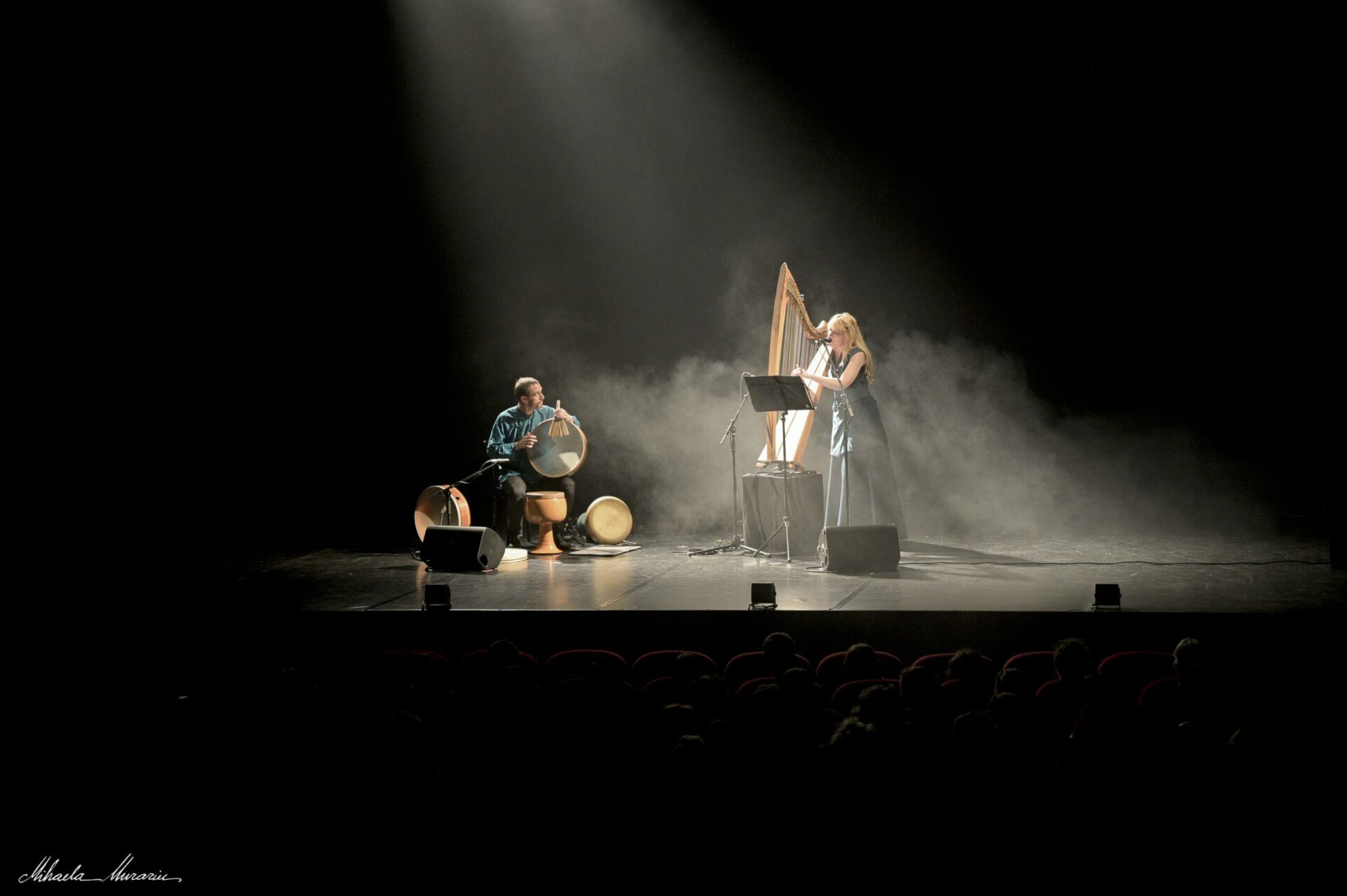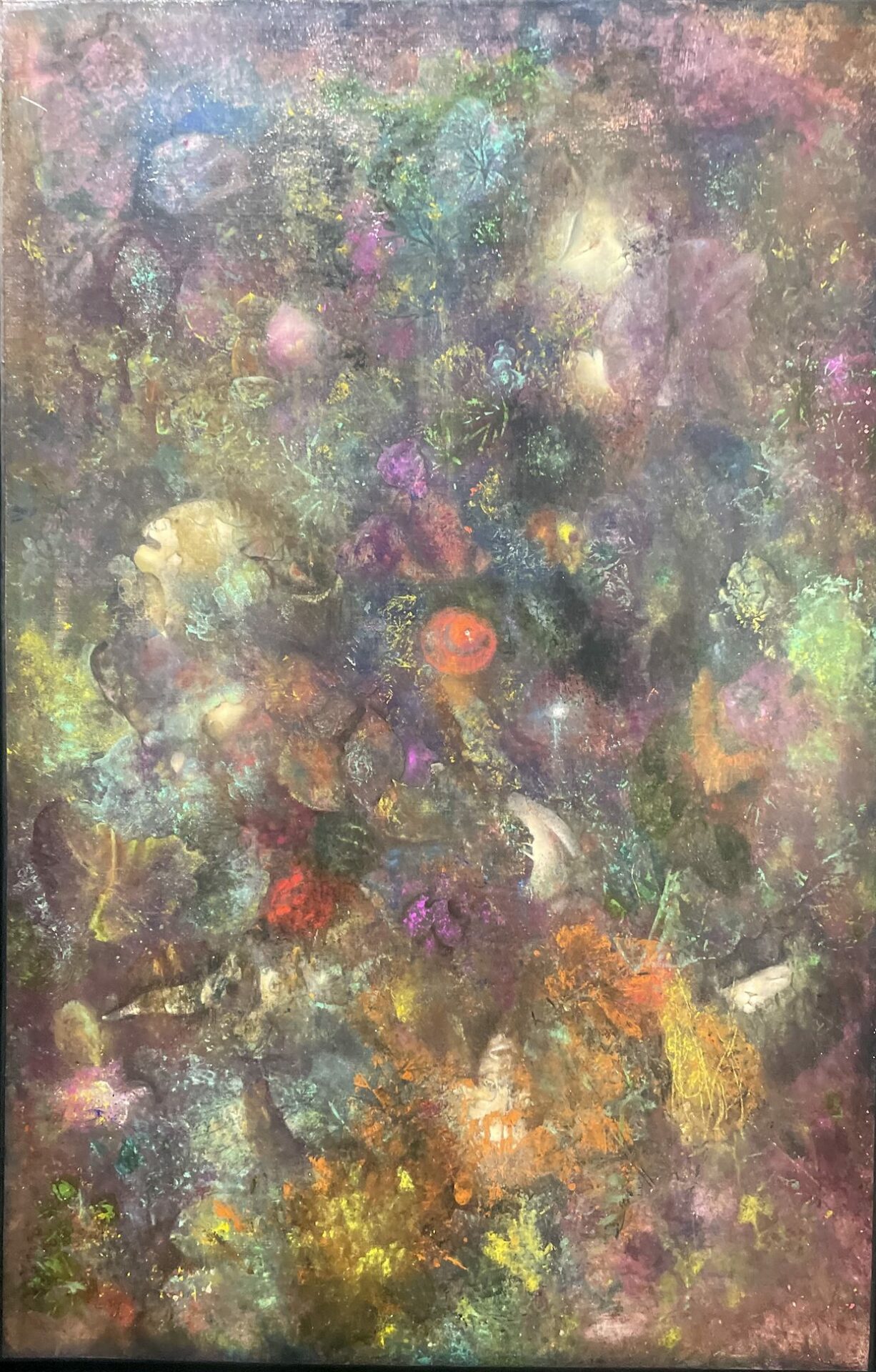Origine
 In my early concerts, I played my own compositions, and the audience would often come up to me and ask me about the origin of the pieces I was performing, whether they were Sephardic music or not. At the time, I had no idea what Sephardic music was. I was barely twenty and had a particular affinity, an instinct, for oriental modes and melismatic vocality.
In my early concerts, I played my own compositions, and the audience would often come up to me and ask me about the origin of the pieces I was performing, whether they were Sephardic music or not. At the time, I had no idea what Sephardic music was. I was barely twenty and had a particular affinity, an instinct, for oriental modes and melismatic vocality.
My harp quickly carried me away to oriental rhythms and imagery that felt very natural and organic to me.
About ten years ago, my mother and I tracked down a cousin with a passion for genealogy, who told us we had Sephardic roots.
After this meeting, I went to the Centre de Musiques Juives in Paris and began to do some research. It was with amazement that I discovered these Sephardic melodies, which I thought I already knew without having learned them. The words of the tunes I’d been carrying inside me were revealed.
Up until then, I’d been composing from improvisation, singing in tongues, searching for the words to the music that inhabited me. Now, at last, I found the words and their meaning in Ladino, the language used by the Sephardim, a mixture of ancient Spanish and Hebrew.
I then decided to dedicate an entire musical program to it, as if to re-establish this oral transmission that I have never received from mother to daughter other than through this memory that I carry, song of my flesh, song of my soul, from murmur to cry, and which gave birth to this record: “De Femmes en Femmes”.
Heritage
 When the Catholic kings expelled the Jews from Spain in 1492, a culture rich in two thousand years of history spread throughout the Mediterranean basin. Wherever they went, Sephardim took their cultural heritage with them, as well as the Judeo-Spanish language most often called Ladino. The traditional Sephardic repertoire is a women’s repertoire. It was through women, from mothers to daughters, that these songs were passed on orally down the centuries. These songs speak of their lives, their daily lives, exploring themes of love, the divine, solitude, expressing their intimate pain, their love, their hopes, celebrating life through messages of wisdom passed on to future generations. I chose to arrange a few titles on the harp, adding poetry readings and one of my own compositions: L’Envol d’Arzach.
When the Catholic kings expelled the Jews from Spain in 1492, a culture rich in two thousand years of history spread throughout the Mediterranean basin. Wherever they went, Sephardim took their cultural heritage with them, as well as the Judeo-Spanish language most often called Ladino. The traditional Sephardic repertoire is a women’s repertoire. It was through women, from mothers to daughters, that these songs were passed on orally down the centuries. These songs speak of their lives, their daily lives, exploring themes of love, the divine, solitude, expressing their intimate pain, their love, their hopes, celebrating life through messages of wisdom passed on to future generations. I chose to arrange a few titles on the harp, adding poetry readings and one of my own compositions: L’Envol d’Arzach.
The Duo Racines

With its original Celtic harp instrumentation, played by Sophie Leleu to accompany her powerful, deep vocals, and digital percussion from the East (Turkey, Iran, Middle East…) played with finesse and dexterity by Antoine Morineau, the duo Racines is full of promise.
Following Sophie Leleu’s discovery of her Sephardic origins, she decided to devote an entire program to them, mixing it with her own compositions : a program about women. During their exodus, Sephardim carried their traditions with them, blending their music with the cultures of the various host countries they encountered. Sophie Leleu calls on the talent of Antoine Morineau or Marti Uibo Ilmar to explore together the colors and dynamics of these traditional songs, alternating writing, improvisations, trance and poetry readings, which they color on the harp and set to the rhythm of the zarb, the dohola, the daf, the bendir, the req or the udu…
The Racines duo was then invited to perform at various festivals and concerts, often in places of heritage or worship, thus revealing the spiritual dimension of this music.
Critiques
“Moments of grace with Sophie Leleu and Antoine Morineau :
What better than the prestigious setting of the synagogue to welcome Sophie Leleu, internationally renowned mezzo-soprano and harpist, and Antoine Morineau, percussionist.
The duo Racines presented their program of Sephardic melodies “De Femmes en femmes”. The audience is immediately won over by the couple’s complicity and musical intelligence. With her warm, powerful, melodious voice and graceful movements, Sophie, who is at one with her harp, and Antoine, take the audience along, captivated, under the spell, who close their eyes and let themselves be lulled by melancholy pieces such as “La Serena”, but also cheerful and lively, making them want to dance, such as “Dos amantes tengo la mi mama”…. The couple develop exceptional mastery and virtuosity, and the audience is in ecstasy, applauding wildly and having only one word: “During the finale, they even join in the chorus with Sophie in Hebrew. Thanks to Sophie and Antoine for a fantastic time. Such emotion. Sublime.”
P. de R. / Journal La Provence
“The first concert, “De femmes en femmes” (From Women to Women), based on the traditional Sephardic repertoire, is a marvellous illustration of the transmission of songs from mothers to daughters, in an evocation of their daily lives. Sophie Leleu’s dexterity on the harp and her spellbinding voice offered the audience a true moment of bliss, magnificently accompanied by Antoine Morineau. “
Vaucluse matin newspaper
“With her presence, her graceful harpist’s gestures and her heaven-fallen voice, Sophie LELEU has all the trump cards up her high priestess sleeves when it comes to captivating an audience… The duo exudes such musical intelligence, that an economy of means results in a wealth of harmonic emotions between strings and skins. I believe that beauty can stand on its own. You don’t need to be a specialist in learned music to appreciate such a work. When the best performers give their all, and soul takes precedence over technique… What remains is the bliss of a conquered audience… Yerushalayim!”
Pascal David / Juke Boxe en Avignon – web magazine
“How can pure talent be rewarded if not with praise so well deserved, for merit is there. Sophie Leleu doesn’t just have a voice, she has an extra soul, a voice certainly dictated by angels, an extraterrestrial range, and yet her songs come from the mists of time.
Poetic and mischievous, she recounts the emotions of women as they have always been. Sophie Leleu is her harp, which I’m sure has a soul. She’s a character in the show, more than a musical instrument.
Percussionist Antoine Morineau, the only male member among them, knows how to be so attentive, so enveloping, that I could feel the sounds of his percussion dress the harpist, embracing her like a veil, a garment that covers her and reveals her at the same time. What is given in this show cannot be repeated, and the audience is not mistaken: it feeds on this unique musical gift.
I was transported in this church of St Symphorien, lulled by the beauty in which we were bathed, a moment of sharing, an egregore of positive healing and antidepressant. Giving thanks is the least we can do when we’re lucky enough to just have to be there, attentive to the present.”
Natacha Régnier-Ledieu / Tête d’Aie Art Media – web magazine














